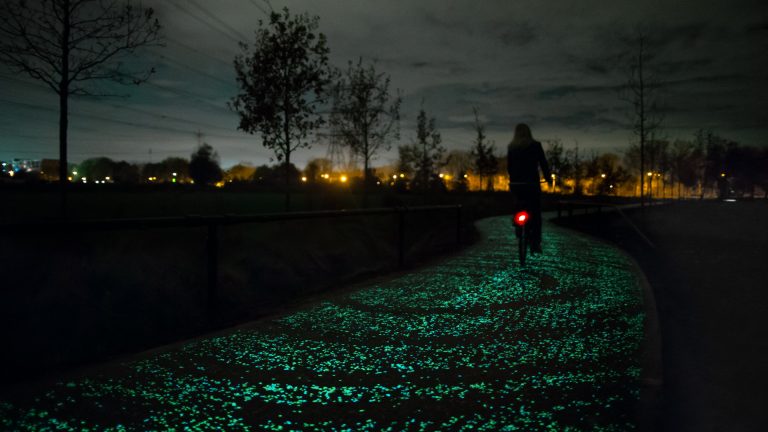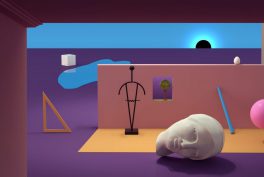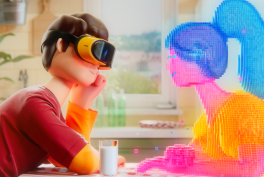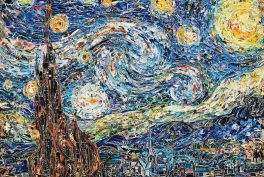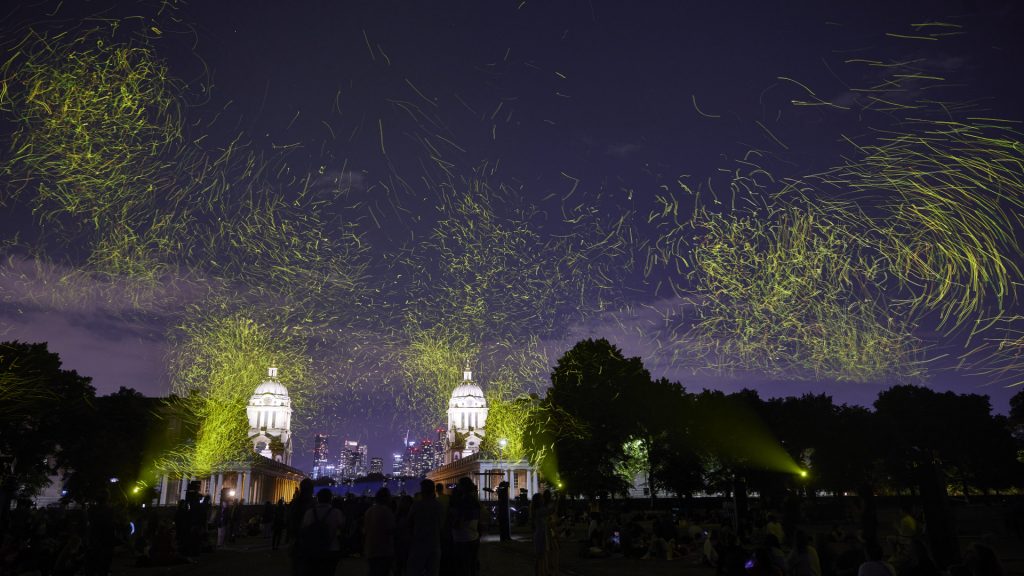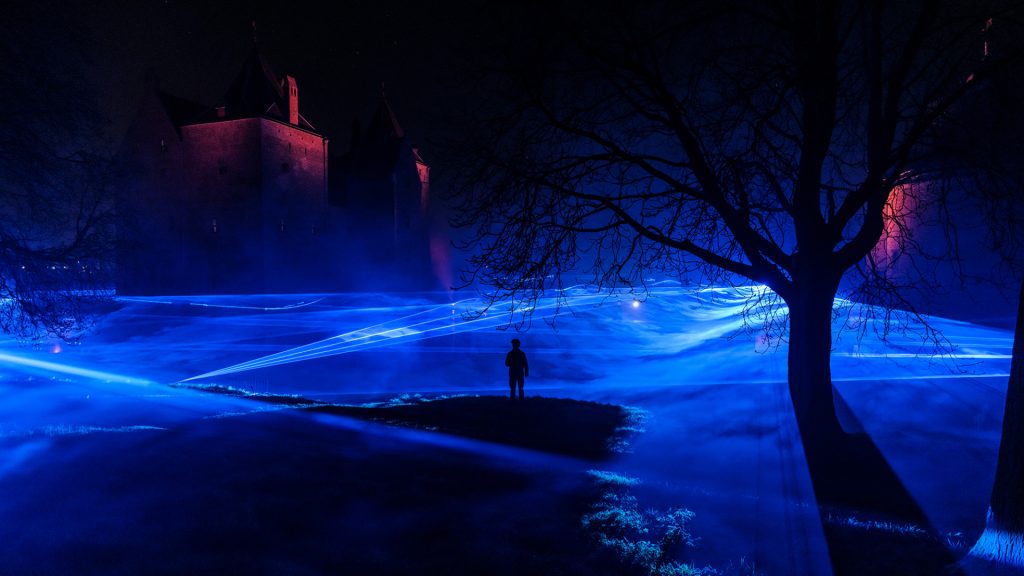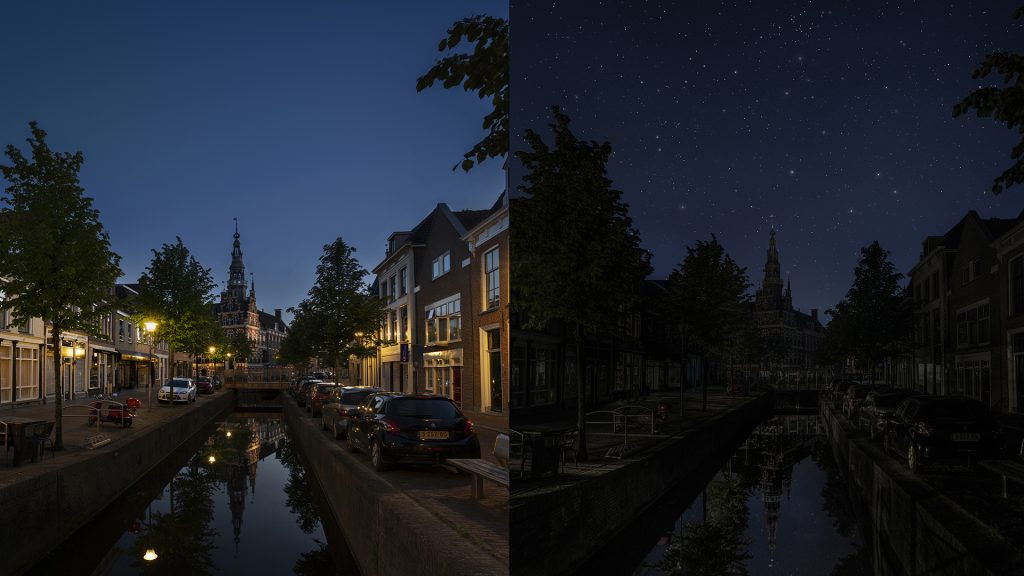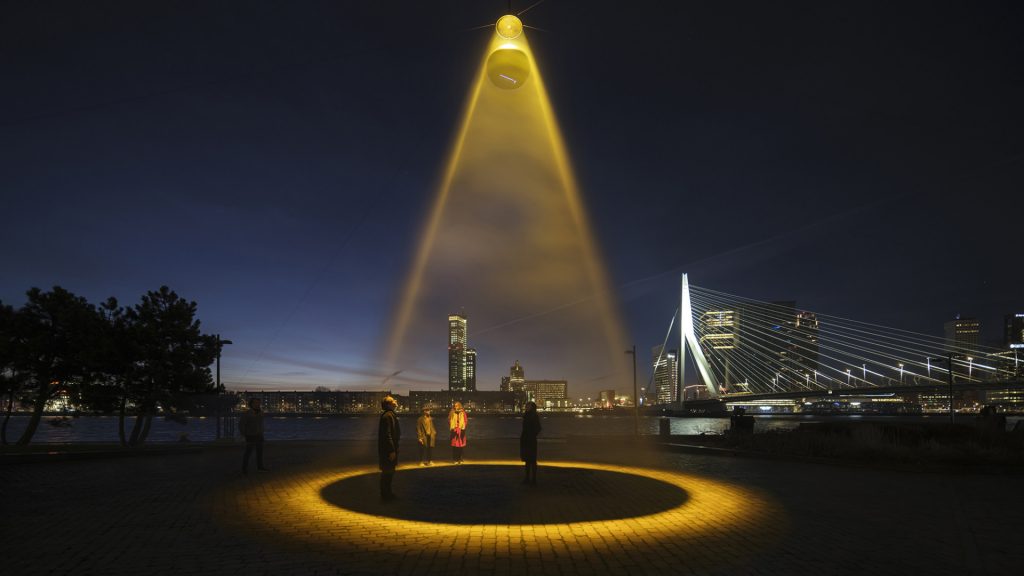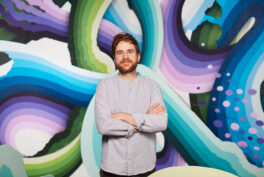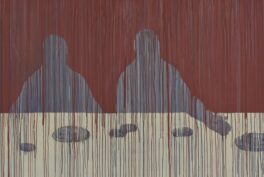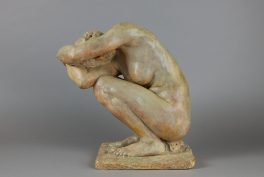The projects of the studio include such works as Waterlicht, a virtual flood showing the power of water, Smog Free Project, the world’s first outdoor air purifier which turns smog into jewelry, and Smart Highway—roads that charge throughout the day and glow at night. Others are Space Waste Lab, about visualizing and up-cycling space waste, the world’s first Urban Sun that cleans public spaces of the coronavirus, or, more recently, Seeing Stars, switching off all the city lights to bring back the stars.
Clean air, clean water, clean energy, and clean space are the studio’s values and in his Phaidon monograph where Daan Roosegaarde explains:
We first have to imagine a better future, and only then can we create it. People won’t change because of numbers. But if we can trigger curiosity for a better world, that’s how to activate people. I don’t believe in utopia, but in protopia; improving the world around us step by step.
Some time ago I had a chance to interview Roosegaarde on how he sees the world in the future and what role art has in that. Moreover, he shared with me what projects he is working on right now.
Agnieszka Cichocka: Daan, how do you find inspiration for your works?
Daan Roosegaarde: It comes from the inspiration of the world around me, but also from irritation, so to speak, because the world is sometimes confusing. You don’t really understand it, and you try to improve it. But there’s also my personal fascination with space waste, air pollution, or how we celebrate together with fireworks… I get annoyed, I get irritated, I get inspired, and I try to improve. Basically, that’s what drives it. So everything I create is really idea-driven. It is not so much about technology or funding. We usually initiate a project and the client comes later because I know nobody is going to call me and ask “Can you please make the largest smoke vacuum cleaner in the world?”.
AC: When you think of the year 2040, how do you think that art, technology, and science will merge? And what will the role of the artist be?
DR: Many people have tried to define utopia – the perfect world, but it’s always been a sort of a rainbow in the sky that we’ve never been really able to grasp. So maybe we should let go of the idea of utopia, or dystopia for that matter, but focus more on protopia. It’s an old phrase Kevin Kelly coined years ago, where you try to improve, where you learn, where you feel and do all step by step. I think we should define the values which we find important. For example, clean air, clean water, and clean energy, and then just try to figure out how to make them part of our daily lives. We have these really important things, but we don’t know how to value them. And that is why I use beauty as a strategy to help people accept change. Look here we can make biodegradable fireworks, or look here we can make ten airparks, or look here we can make bicycle parks that charge during the daytime.
So I think they’re very much prototypes for the year 2040. I hope we will make technology become more human again, instead of how it works right now, where we’re just feeding computer screens and all we get back is a lie. That’s a bad deal. So we have to renegotiate this relationship between nature, people and technology. And I find that fascinating.
Maybe in 2040 we can change our perception and realize that we can not control nature or climate, so we have to change our attitude and our position, and that might change everything.
AC: I think now we already know that we’re not in the center of the universe, but as people, we really want to be.
DR: That’s why I became really addicted to creating these sorts of atmospheres. Waterlicht is a dream landscape about the power and poetry of water. As a virtual flood, Waterlicht shows how high the water level could reach. It is a collective experience to remind us of the importance of water innovation and the impact of climate change. People don’t change because of the numbers. But when you see it and you feel it, some people get scared, some people get curious, and everybody starts to whisper. So it’s sort of a truly collective experience. Art is a great tool for people to be more curious about the future. And I hope and notice that by creating these sort of memescapes, people open up because they see something beautiful and they dare to wonder and they dare to dream again.
I think beauty can help us accept change, and we’re not using that enough as a strategy. We talk about numbers, we talk about politics, and we talk about money, but we don’t use beauty as a strategy. Take a project Seeing Stars. Together with UNESCO Netherlands, we brought back the stars to create a sense of connection with each other, something that was missing during the COVID-19 pandemic. And people crave this sense of community. By removing light pollution, we’re revealing the starlights, which have been there for millions of years. I love that about Seeing Stars, that by actually removing something, you get something back. You can experience the beauty of doing less. I didn’t design those stars. They have been there for millions of years, but I can activate the people to experience that together.
AC: Do you feel like any of your projects could be launched commercially, on a large scale?
DR: Of course, they need to grow, and they are growing in their own way. That’s why actually UNESCO is involved in the Seeing Stars project. Everybody has the right to see the stars. It should be Universal Heritage.
AC: I think your projects are very forward-thinking. How do you look for things that might later impact your projects?
DR: It’s very personal. Some mornings you wake up and you’re inspired by a breaking dawn. Sometimes people say, I have an idea. And I reply – no you don’t have an idea, you don’t own an idea. You surrender to an idea. And you follow the idea. You feed the idea with your time, money, love, energy, and deep work. So there’s sort of openness in that. So when I have a new idea, it’s not a secret. I’m sharing it with all taxi drivers worldwide. And I’m sharing the story with them, and they’re giving me harsh feedback. If you want to know what people might think of your project, pitch to the taxi driver.
Of course, I follow architecture, design, and technology. I read scientific journals. I caught myself last week looking at the wing of a butterfly again. How does the wing of a butterfly always remain fitted in terms of color without the toxic pigment in our clothes?
AC: So what are you working on at the moment?
DR: Myself? I was watching a documentary about geoengineering, how to make it rain. Can we make a hole in the clouds to bring the sun when it’s cloudy? In a way, we’re already designing the weather – with our emissions. Very controversial but I was doing some research on that. Will we be designing the weather? The question is, who owns it? Who controls it? Are we going to do good or bad? But that’s definitely a theme.
So that’s what I’m working on. And there are so many things. Some are very fragile. I’m trying to figure out if I can communicate with fireflies by programming LEDs in the same frequency as they’re using to communicate with each other.
But of course, there’s a super extensive network of teams of scientists, engineers, project managers, firefly experts, and mayors. All the projects require huge amounts of people and decisions and failures and prototypes. I think a good project creates a sort of demand or feeling or need in a way that wasn’t there before.
I think in the future we will start growing things, not building things that much. So the scientific research that has been done works on shoes that grow during travel to Mars. So the moment you are on Mars, your shoes are grown. And as a person, I think we should focus on realizing creativity, the ability to think, to discuss the debate, and to reshape our ideas. And that again is still something computers and robots are still bad at for the moment.
